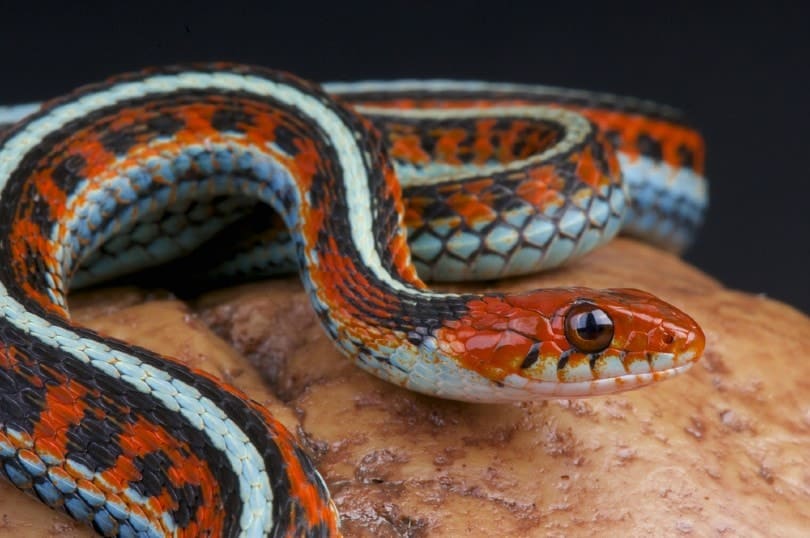Illinois is home to more than 35 species of snakes. Illinois snakes are typically found in grasslands, swamps, forests, rivers, and ponds during warmer months of the year. During the winter, snakes go underground and enter a state called brumation, where they remain inactive until the weather warms up again.1 While some species can be kept as pets, it’s important to remember that it is illegal to capture and keep any wild snakes in Illinois. Responsible reptile breeders and pet stores may sell snakes that are legal for you to own. Let’s take a look at the top 12 common snakes found in Illinois.

The 12 Snakes Found in Illinois
The 4 Non-Venomous Snakes in Illinois
1. Garter Snake
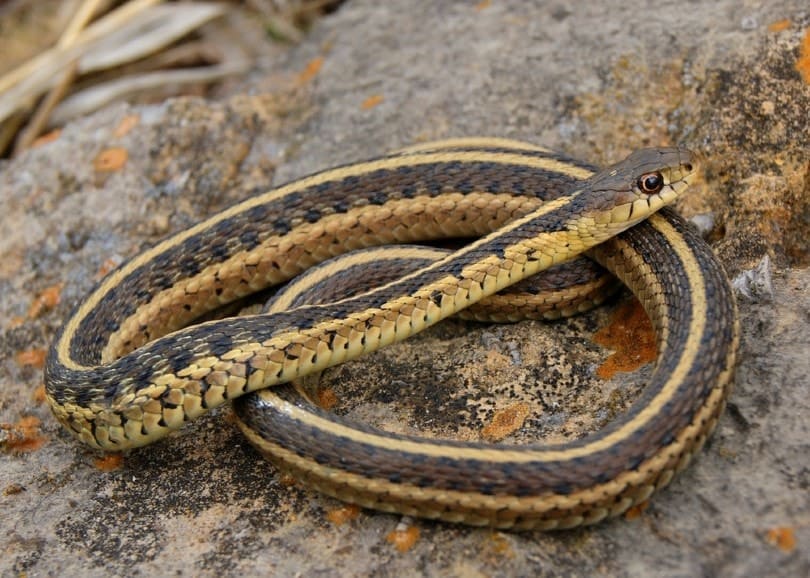
| Species: | T. sirtalis |
| Longevity: | 4 – 5 years |
| Good to own as a pet?: | Yes |
| Legal to own?: | Yes |
| Adult size: | 23 – 29 inches |
| Diet: | Carnivorous |
The Garter Snake is the most common and easily found snake in Illinois. You can identify this snake by their brown or black color and three yellow lines that run horizontally down the body. The Garter Snake is quite harmless to people. Seeing one in your garden or grass can mean that other pests, such as rodents and insects, are being kept at bay as part of the snake’s diet. The Garter Snake hangs out in grassy areas and can also be found by ponds and lakes. They’re a good swimmer and will eat fish and amphibians in addition to small mammals and bird eggs. Predators of this snake are foxes, hawks, and often, your lawnmower. Before mowing your lawn, check the sunny patches of your grass for any Garter Snakes that may be relaxing and enjoying the warmth. They’ll likely hurry away when you appear.
2. Ring-Necked Snake

| Species: | D. punctatus |
| Longevity: | 10 years |
| Good to own as a pet?: | No |
| Legal to own?: | Yes |
| Adult size: | 9 – 15 inches |
| Diet: | Carnivorous |
In Southern Illinois, you’ll find the Ring-Necked Snake living primarily in wooded areas, prairies, and bluffs. These snakes have a dark brown or blue back, with a bright yellow or orange belly. Their defining characteristic is a light yellow ring around their necks. They enjoy feasting on frogs, salamanders, worms, and small lizards. Their natural predators include owls, skunks, possums, and sometimes larger snakes. They are often difficult to breed when in captivity, so many Ring-Necked Snakes are illegally captured from the wild and traded. This snake is docile, but when it senses danger, they will curl their tail into a coil. This is a characteristic that they are known for, and this position is designed to pose a threat to a perceived predator. If the snake is endangered further, they will play dead.
3. Hognose Snake
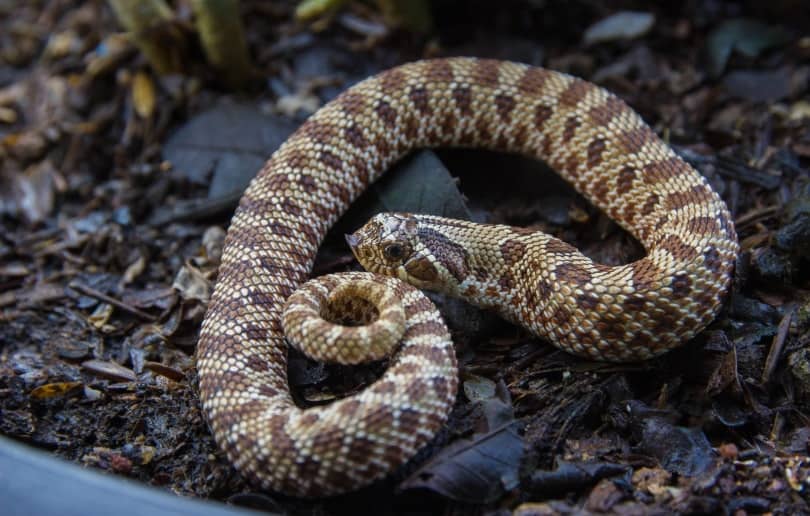
| Species: | H. platirhinos |
| Longevity: | 9 – 20 years |
| Good to own as a pet?: | No |
| Legal to own?: | Yes |
| Adult size: | 13 – 46 inches |
| Diet: | Carnivorous |
The Hognose Snake is olive, tan, brown, or black and may be covered in dark blotches. They are commonly found in sandy areas along the Central Illinois River, and you’ll recognize this snake by their upturned nose and stocky body. These features help them easily burrow through the sand. They love to eat frogs and toads, but they will also consume small birds, insects, and lizards. They serve as food for hawks, owls, and other predatory birds. The Hognose Snake is sometimes called a “Puff Adder” because of their ability to flatten their head and puff out the skin around it when feeling threatened. They hiss, giving the impression of a Cobra, and will even strike (with their mouth closed!). This is the snake’s way of protecting themselves. If that doesn’t make the threat disappear, the snake will play dead until it’s safe.
4. Kingsnake
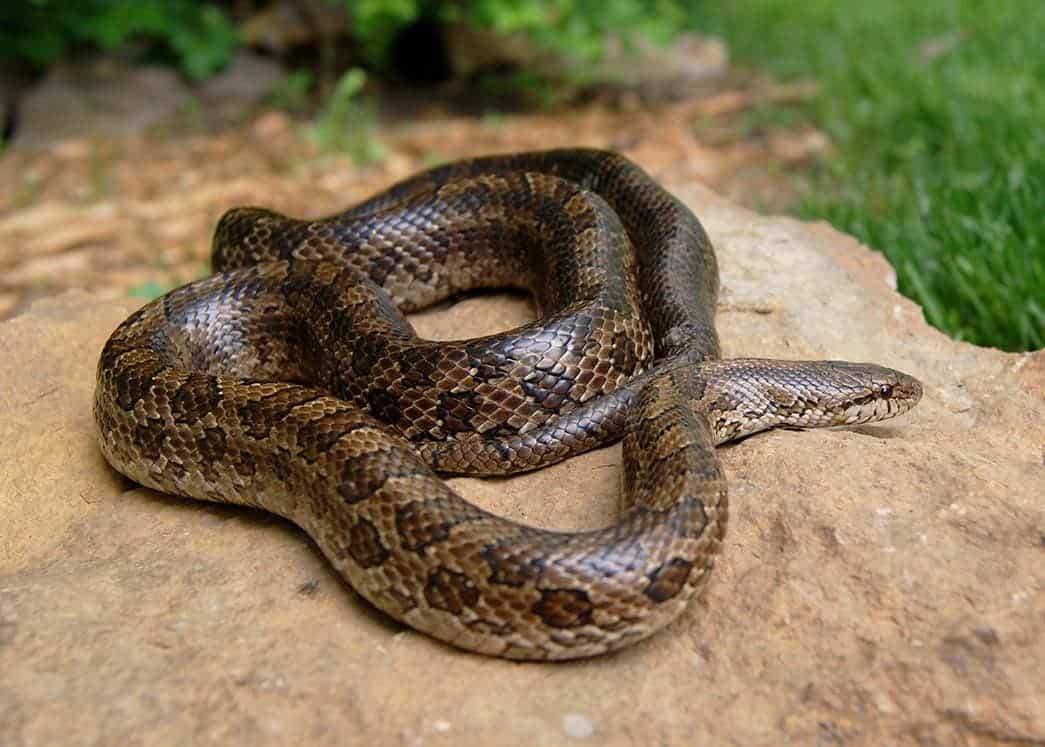
| Species: | L. getula |
| Longevity: | 15 – 25 years |
| Good to own as a pet?: | Yes |
| Legal to own?: | Yes |
| Adult size: | 36 – 60 inches |
| Diet: | Carnivorous |
The Kingsnake is named as such because of their venom immunity. They don’t fear venomous snakes because their immunity enables this snake to kill and eat them. You’ll find Speckled and Black Kingsnakes in the Southern half of Illinois. These snakes will be hanging out in woodsy areas, swamps, and stream valleys. They hide under rocks and logs and kill their prey by constriction. They have dark bodies with light specks in the center of their scales, giving them a speckled appearance. They are also known as “Salt and Pepper Snakes.” Their diet consists mainly of other snakes, small birds, turtle eggs, and rodents. Hawks, owls, coyotes, and possums are natural predators of the Kingsnake.
The 4 Watersnakes in Illinois
Certain species of snakes are good swimmers and enjoy being in and near water. Here are a few to keep an eye out for in the wet areas of Illinois.
5. Western Ribbon Snake

| Species: | T. proximus |
| Longevity: | 12 – 20 years |
| Good to own as a pet?: | No |
| Legal to own?: | Yes |
| Adult size: | 24 – 36 inches |
| Diet: | Carnivorous |
Where there’s water, you’re likely to find the Western Ribbon Snake. They like wetlands and marshes where they can swim and capture prey. Their diet mostly consists of frogs and other amphibians, but they are known to eat bird eggs, tadpoles, and fish as well. You can identify this snake by their dark brown or olive scales and three orange horizontal stripes down the length of their body. The Western Ribbon Snake serves as a food source for weasels, large fish, other snakes, and turtles. When captured, this snake also can completely shed their tail. While the tail won’t grow back, shedding it enables the snake a chance to free themselves from harm and survive.
6. Mississippi Green Watersnake
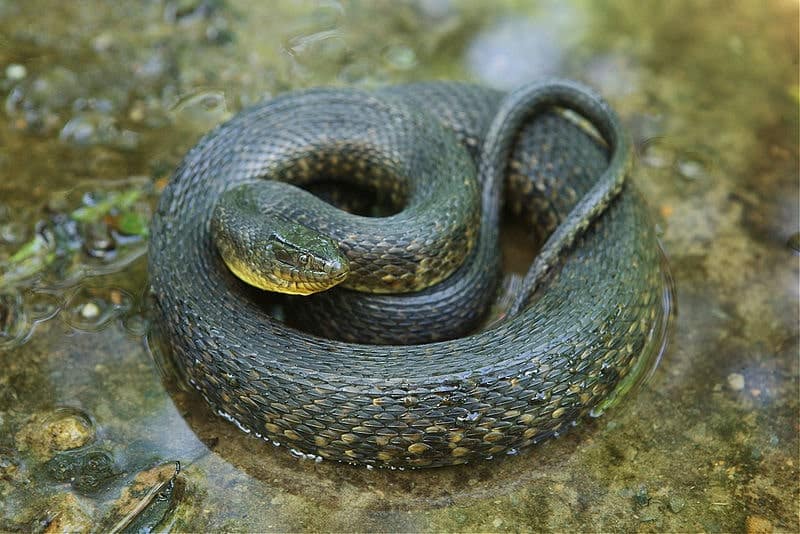
| Species: | N. cyclopion |
| Longevity: | 9 – 10 years |
| Good to own as a pet?: | Yes |
| Legal to own?: | Yes |
| Adult size: | 30 – 45 inches |
| Diet: | Carnivorous |
In flooded woodlands along the Mississippi River, you’ll find the Mississippi Green Watersnake. These dark green or brown snakes are speckled with dark spots and have pale yellow bellies. They like to eat fish and small amphibians. Their natural predators include shorebirds and larger snakes. Quiet and preferring solitude, the Mississippi River Snake is harmless. People often confuse them with a Cottonmouth, though, which is venomous to humans. Therefore, this snake is often killed and is now considered a threatened species in Illinois.
7. Diamond-Backed Watersnake

| Species: | N. rhombifer |
| Longevity: | 10 years |
| Good to own as a pet?: | No |
| Legal to own?: | Yes |
| Adult size: | 30 – 48 inches |
| Diet: | Carnivorous |
Having no relation to the Diamondback Rattlesnake, which is venomous, the Diamond-Backed Watersnake doesn’t pose much of a threat. Brown or dark olive, they have a distinctive pattern that resembles a netting of dark diamonds down their back. They have a light brown or yellow belly. Like the Mississippi Green Watersnake, these snakes are often killed because people think that they’re Cottonmouths or Rattlesnakes. Humans pose the biggest threat to their survival. Eagles, foxes, coyotes, and hawks view this snake as a food source. When hunting for food, this watersnake dips their head into the water while hanging from a low branch. They wait for small fish or other small prey, like frogs or toads, to swim by and then strike. You’ll find this snake in and near streams, swamps, and rivers.
8. Kirtland’s Snake

| Species: | C. kirtlandii |
| Longevity: | 8 years |
| Good to own as a pet?: | Yes |
| Legal to own?: | Yes |
| Adult size: | 14 – 18 inches |
| Diet: | Carnivorous |
In the wet fields and prairies of Illinois, you can find the Kirtland’s Snake. They’re always found near water but spend less time in it than other watersnakes. This snake has keeled scales, meaning there is a raised ridge on the edges. The scales are usually dark gray, with rows of dark blotches down the body of the snake. The white chin and throat lead to a red belly, which is lined with dark spots. When they feel scared or in danger, this snake can flatten their body and go rigid, blending in with their surroundings. Unfortunately, the Kirtland’s Snake is classified as threatened in Illinois. Most of their natural habitats have been destroyed. Their diet primarily consists of earthworms and slugs, which have been greatly depleted due to pesticides.
The 4 Venomous Snakes in Illinois
While there are many types of snakes in Illinois, the state is home to only four that are venomous and dangerous to humans.
9. Eastern Massasauga Rattlesnake
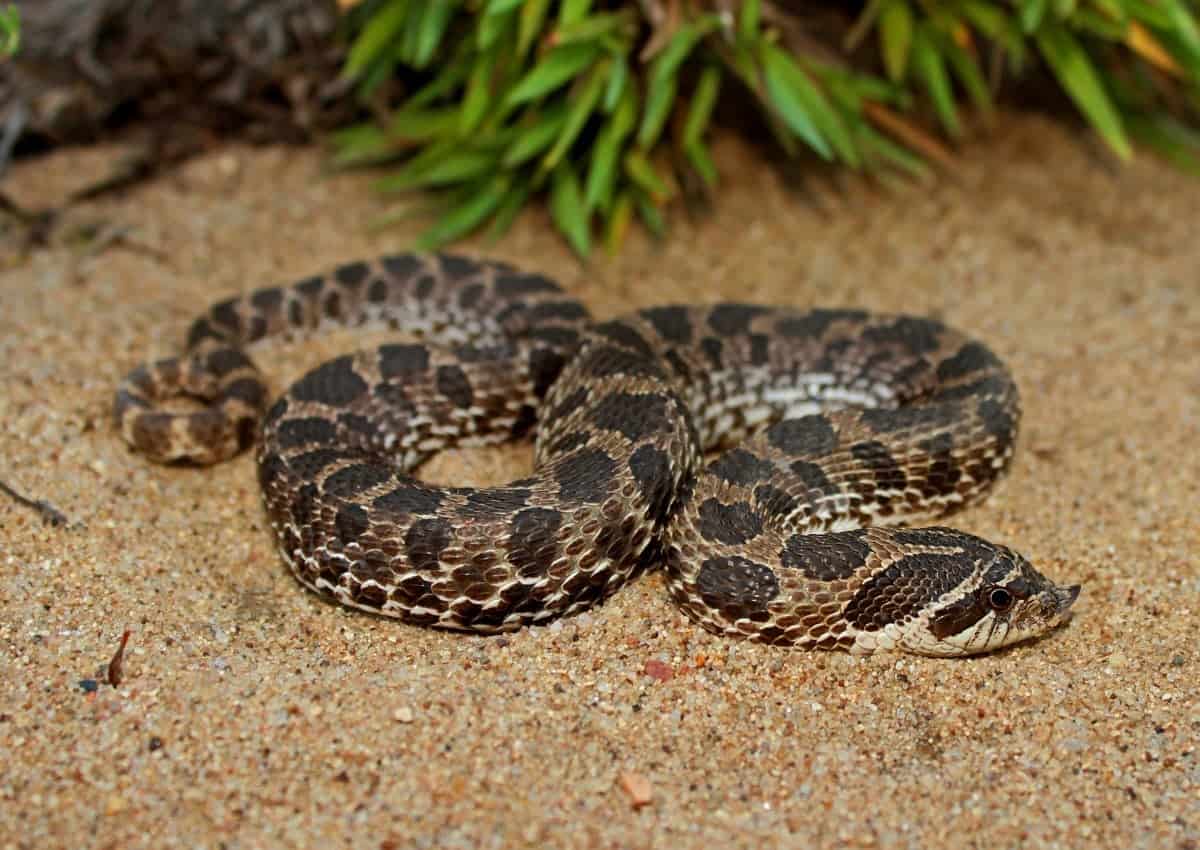
| Species: | S. catenatus |
| Longevity: | 20 years |
| Good to own as a pet?: | No |
| Legal to own?: | No |
| Adult size: | 24 inches |
| Diet: | Carnivorous |
Due to farming wiping out most of their natural habitat, the Eastern Massasauga Rattlesnake is endangered. It is illegal to harm, hunt, kill, or capture them. They’re known as the “Swamp Rattler.” They live in bogs, wooded areas, and under rocks and logs in the Northern half of Illinois. They primarily hunt rodents for food but eat small birds and frogs too. Natural predators include eagles, herons, and other snakes. You’ll notice this snake’s gray body with dark gray blotches down the back and sides, a rattle on the end of the tail, and vertically elliptical pupils. The scales are keeled and the head is flat and wide. If you come across this snake, the best thing to do is leave them alone, turn around, and walk away.
10. Timber Rattlesnake

| Species: | C. horridus |
| Longevity: | 10 years |
| Good to own as a pet?: | No |
| Legal to own?: | Yes |
| Adult size: | 36 – 40 inches |
| Diet: | Carnivorous |
The Timber Rattlesnake can be found in Southern Illinois along forested bluffs near the Mississippi River. They spend most of their time hiding, especially in extreme heat. Their bodies are yellow-brown or gray with dark brown or black crossbands, which are usually shaped like a V or M. The rattle is present at the end of the tail. This snake may have long fangs and produce a significant amount of venom in a bite, but it takes a great deal to get them to strike. They’d prefer to warn you off with a rattle. If you happen to disturb this snake, leave them be and exit the area. The Timber Rattlesnake is listed as threatened due to the loss of their natural habitat and being killed by humans. They live on a diet of rodents and small birds but will eat the occasional frog or toad. They also have plenty of natural predators, including owls, hawks, coyotes, foxes, and even cats.
11. Cottonmouth Snake
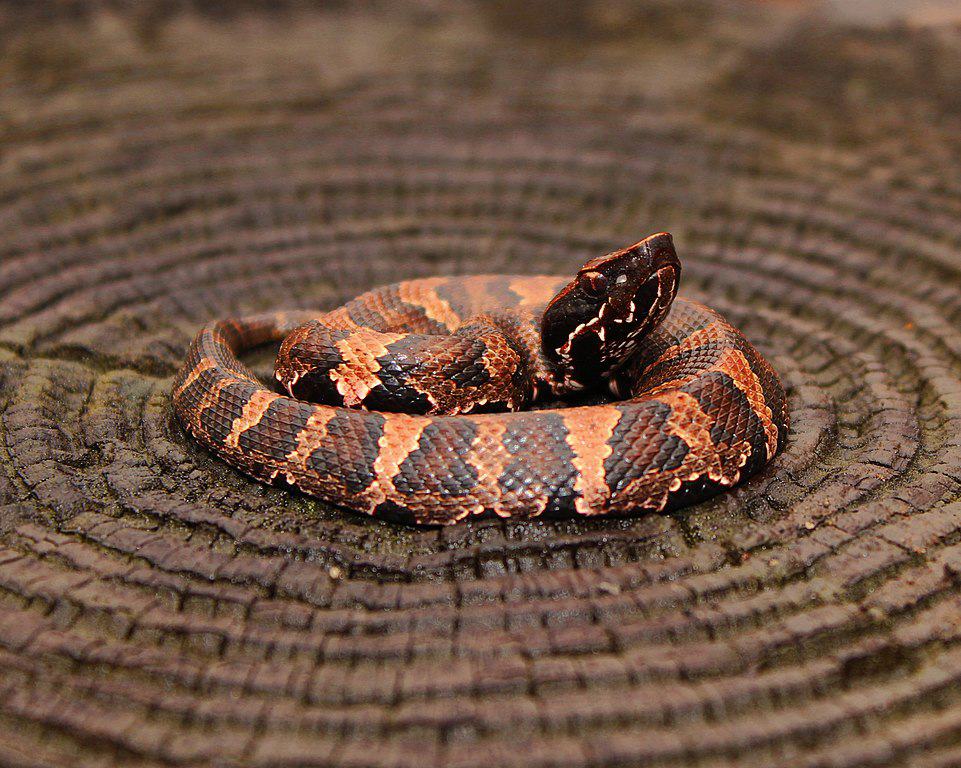
| Species: | A. piscivorus |
| Longevity: | 15 – 20 years |
| Good to own as a pet?: | No |
| Legal to own?: | Yes |
| Adult size: | 30 – 48 inches |
| Diet: | Carnivorous |
The Cottonmouth Snake is named for the white coloring on the inside of their mouth. When they feel threatened, they coil up their bodies and open their mouths to show their fangs. They are considered one of the most dangerous snakes to humans, with a potent venom that can be deadly. Cottonmouths are comfortable swimming and are usually found near water in Southern Illinois. They also enjoy basking in the sun near streams and rivers. Olive or dark brown in coloring, they sometimes have dark bands around their body, with a tan or yellow belly that’s also marked with black spots. They eat fish, turtles, birds, frogs, and small mammals and are sometimes eaten by large fish and birds. Human beings are their biggest predators.
12. Copperhead Snake
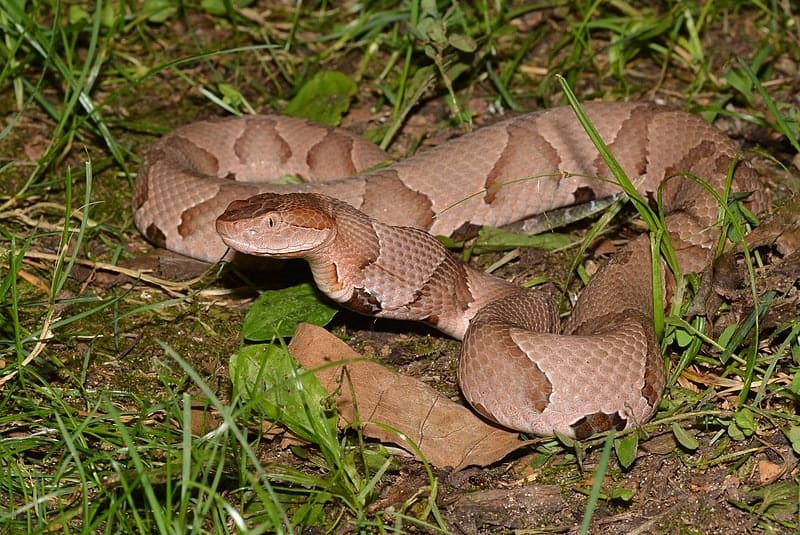
| Species: | A. contortrix |
| Longevity: | 18 years |
| Good to own as a pet?: | No |
| Legal to own?: | Yes |
| Adult size: | 24 – 36 inches |
| Diet: | Carnivorous |
You can find Copperhead Snakes in the lower Illinois River Valley. This venomous snake is also a watersnake, living in swamps and wetlands. Reddish-pink or pale tan, this snake has light tan bands around their body and a pale belly. When feeling scared, the snake will freeze instead of trying to get away, blending in with their surroundings until the danger has passed. Owls and hawks are predators of the Copperhead, while the snake enjoys eating mice and birds. If you see a Copperhead, leave them be and walk away. Copperheads account for more snake bites to humans than any other snake in the United States, but they will only bite if they feel like they have no other choice.

Conclusion
With so many snake species in Illinois, it’s always important to be on the lookout for them if you’re traveling through the areas that they call home. They’re fascinating creatures that deserve respect and the ability to live happily. By being aware and knowing the dangers, you can prevent harm to yourself and the snakes.
Learn about the snakes with one of these related posts:
- 7 Snakes Without Teeth (With Pictures)
- 34 Snakes Found in Australia (With Pictures)
- 15 Snakes Found in Oregon (With Pictures)
Featured Image Credit by reptiles4all, Shutterstock
